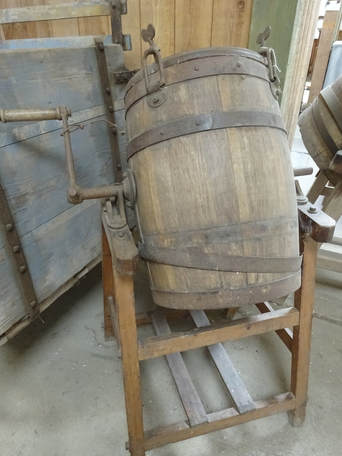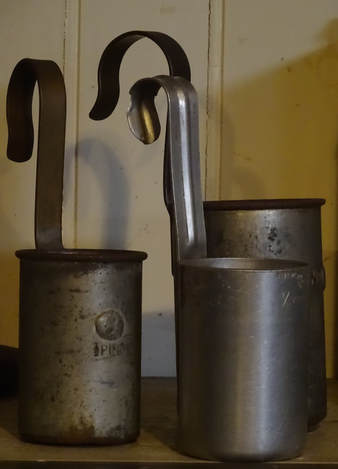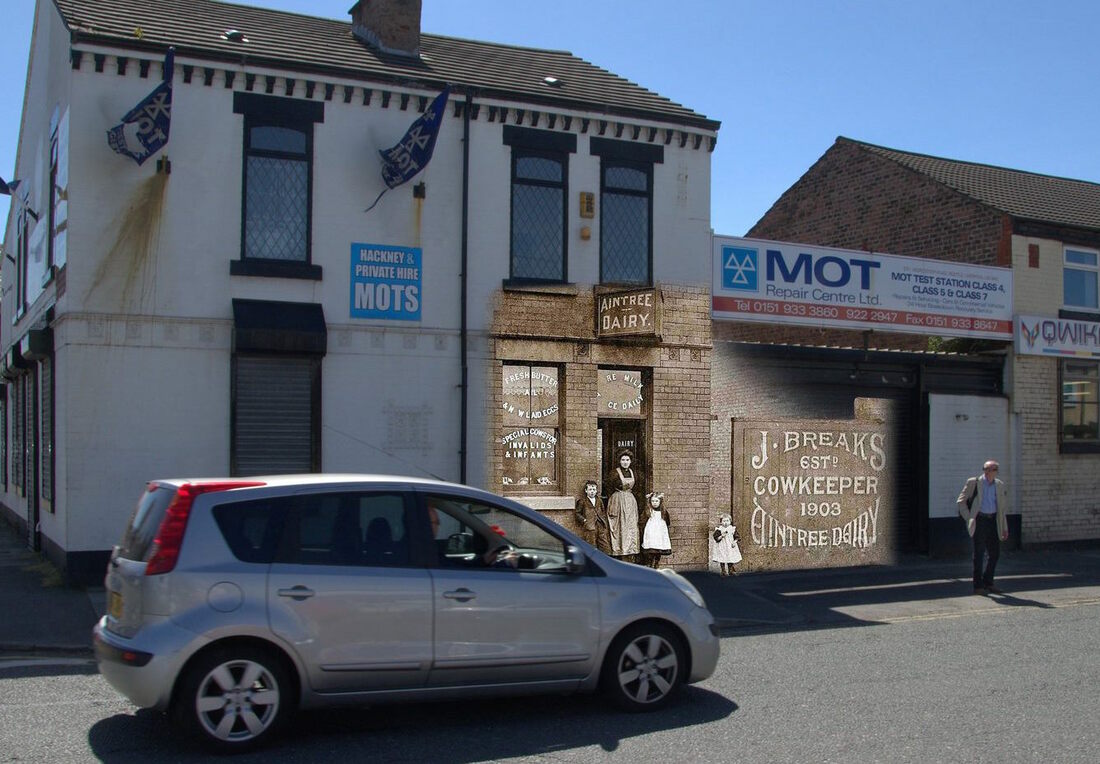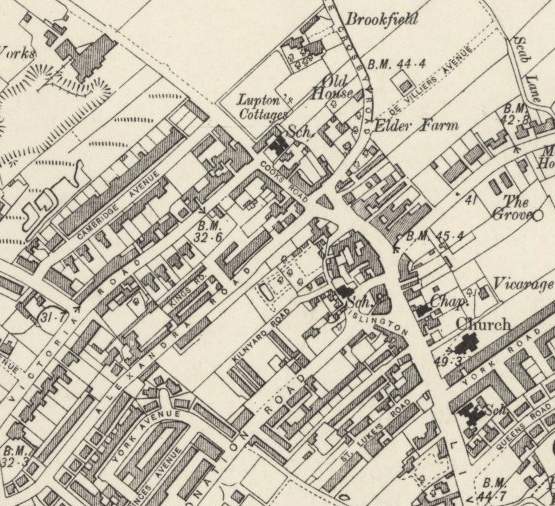I am most grateful to Rosemary McCaffrey for sending me the short memoir of her 1st cousin-once-removed, Marry Gaddas. Mary's memoir describes the days of Orchard Farm Dairy, Crosby, which was first run by her grandfather, John Oversby, and then by her mother and father, Isabella Oversby and John Graham Braithwaite. To give some genealogical context to the memoir, I've provided, below, a brief history of the Oversby family's connections with the practice of keeping cows in Liverpool:
John Oversby (b.1845) was the son of George Oversby (1817-1901) and Isabella Mason (1818-1895). He married Elizabeth Lund (1849-1915) in 1871 at Dent. They had eleven childen: Isabella (b. 1872), Izatt Ann (b. 1874), Agnes (b. 1876), George William (b. 1878), Rose (b. 1880), Michael (b. 1882), Thomas Edward (b. 1884), Anthony Carr (b. 1886), John (b. 1888), Joseph (b. 1890) and Margaret Elizabeth (b. 1892).
In 1891 they were farming at Hill Farm, Garsdale. But by the 1901 census they had moved to Liverpool, where John was a ‘Cowkeeper and Farmer’, living at 55 ALEXANDRA ROAD, Crosby – aka, Orchard Farm. John was living with his wife and eight of their children: John (55), Elizabeth (51), Isabella (29), Agnes (24), Michael (18), Thomas (16), Anthony (14), John (12), Joseph (10) and Margaret (9). Though by the time of the next census, in 1911, John had retired and he and Elizabeth were living at Hall Bank Cottage in Dent, a number of their children also became farmers, dairymen or cowkeepers in Liverpool.
Isabella Oversby (b.1872) took over the running of Orchard Farm after she married John Graham Braithwaite (1873-1925), in 1901. The 1911 census has them living at 113 ALEXANDRA ROAD – the numbering of the properties in Alexandra Road appears to have changed since the previous census. John’s occupation is given as ‘Farmer and Dairyman’ and he is living with Isabella (39) and their two children: Mary Elizabeth (9) and John Thomas (7).
The list of prize-winners from the annual shows, organized by the Liverpool Cowkeepers’ Association, reflects the change in management at Orchard Farm:
By 1938, the dairy at 113 ALEXANDRA ROAD was being operated by Wilkinson (Dairies) Ltd.
Agnes Oversby (1876-1964) married Richard Tenant (1878-1944) in 1906 at Sedbergh. In 1911 they were keeping cows at 36 ST LUKES ROAD, Crosby: Richard (32, Cowkeeper), Agnes (34), Barbara Elizabeth (2) and Agnes (1); also, Robert Tennant (23, Cowman).
George William Oversby (1878-1944) married Mary Ann Marsh (1881-1928) in 1900, at Bootle. He was a ‘Carter’ living at 6 Salisbury Street (1901) before being a ‘Cowman’ living at 2 Forefield Lane (1911). He emigrated to Australia in 1924.
Rose Oversby (1880-1969) married Jabez Breaks (1866-1951) in 1899 at Liverpool. In 1901 they were keeping cows at 4 SEA VIEW ROAD: Jabez (34, Cowkeeper), Rose (20), John (1) and also William Oversby (42, General Labourer). In 1903 they moved to 4 AINTREE ROAD, Bootle, and opened AINTREE DAIRY. The 1911 census records the family living there: Jabez (44, Cowkeeper), Rose (30), John (11), Rose Mary (9), Elsie (7), Elizabeth (5) and Agnes (3). By 1934, the business was being run by Charles Green, whose family continued to do so up until at least 1964.
In 1891 they were farming at Hill Farm, Garsdale. But by the 1901 census they had moved to Liverpool, where John was a ‘Cowkeeper and Farmer’, living at 55 ALEXANDRA ROAD, Crosby – aka, Orchard Farm. John was living with his wife and eight of their children: John (55), Elizabeth (51), Isabella (29), Agnes (24), Michael (18), Thomas (16), Anthony (14), John (12), Joseph (10) and Margaret (9). Though by the time of the next census, in 1911, John had retired and he and Elizabeth were living at Hall Bank Cottage in Dent, a number of their children also became farmers, dairymen or cowkeepers in Liverpool.
Isabella Oversby (b.1872) took over the running of Orchard Farm after she married John Graham Braithwaite (1873-1925), in 1901. The 1911 census has them living at 113 ALEXANDRA ROAD – the numbering of the properties in Alexandra Road appears to have changed since the previous census. John’s occupation is given as ‘Farmer and Dairyman’ and he is living with Isabella (39) and their two children: Mary Elizabeth (9) and John Thomas (7).
The list of prize-winners from the annual shows, organized by the Liverpool Cowkeepers’ Association, reflects the change in management at Orchard Farm:
- 1896 – Fat Cow not exceeding 14cwt. 1st Prize to John Oversby, Orchard Farm Dairy, Crosby.
- 1897 – Fat Cow 14cwt and upwards. 5th Prize to J. Oversby, Orchard Farm Dairy, Crosby.
- 1899 - Fat Cow not exceeding 14cwt. 5th Prize to J. Oversby, Alexandra Road, Crosby.
- 1906 – 4 x Special Prizes awarded to J. G. Braithwaite.
By 1938, the dairy at 113 ALEXANDRA ROAD was being operated by Wilkinson (Dairies) Ltd.
Agnes Oversby (1876-1964) married Richard Tenant (1878-1944) in 1906 at Sedbergh. In 1911 they were keeping cows at 36 ST LUKES ROAD, Crosby: Richard (32, Cowkeeper), Agnes (34), Barbara Elizabeth (2) and Agnes (1); also, Robert Tennant (23, Cowman).
George William Oversby (1878-1944) married Mary Ann Marsh (1881-1928) in 1900, at Bootle. He was a ‘Carter’ living at 6 Salisbury Street (1901) before being a ‘Cowman’ living at 2 Forefield Lane (1911). He emigrated to Australia in 1924.
Rose Oversby (1880-1969) married Jabez Breaks (1866-1951) in 1899 at Liverpool. In 1901 they were keeping cows at 4 SEA VIEW ROAD: Jabez (34, Cowkeeper), Rose (20), John (1) and also William Oversby (42, General Labourer). In 1903 they moved to 4 AINTREE ROAD, Bootle, and opened AINTREE DAIRY. The 1911 census records the family living there: Jabez (44, Cowkeeper), Rose (30), John (11), Rose Mary (9), Elsie (7), Elizabeth (5) and Agnes (3). By 1934, the business was being run by Charles Green, whose family continued to do so up until at least 1964.
Michael Oversby (1882-1936) married Winifred Agnes Aindow (1882-1956) in 1902, at Liverpool. In 1911 they were keeping cows at 191 WORCESTER ROAD, Bootle, along with their three children: Margaret (7), Winifred (5) and John (1 month).
Anthony Carr Oversby (1886-1961) married Mary Ellen Green (b. 1886) in 1908 at Guisborough, Yorks. In 1911 they were keeping cows at 10 IVY LEIGH, Tuebrook: Anthony Carr (24, Cowkeeper and Dairyman), Nellie (25), Florence Agnes (2) and Elizabeth Carr (1).
Margaret Elizabeth Oversby (1892-1943) married Thomas Edward Cornthwaite (b.1890) in 1915 at Holy Trinity Church, Walton – Thomas’s given occupation was ‘Dairyman’. Prior to getting married, in 1911 Thomas was working for his father, Edward Cornthwaite (b. 1865), who was a ‘Farmer and Cowkeeper’ at 4 MARLBOROUGH ROAD, Tuebrook. BY 1939, Thomas was a ‘Farm Bailiff (Cows and Pigs)’, living at South Mox Farm, Formby.
The memoirs of mary gaddas (nee braithwaite)
My Family
My grandparents, John (Oversby) and Elizabeth (nee Lund), came from Dent in Yorkshire to live in Great Crosby village. My parents and other members of the family from Orchard Farm were married at St Luke’s Church, Crosby.
My mother, Isabella (born in 1872), was the eldest of 11 children (5 girls, 6 boys). She married John Braithwaite in 1901.
Orchard Farm
My grandparents lived at Orchard Farm in Alexandra Road. They rented the buildings, which were in two parts, from Peter Leonard (a builder, painter and decorator) and from Charles Townsend. The latter was a builder by trade and he owned a lot of dairy premises in Crosby.
My grandparents lived at Orchard Farm in Alexandra Road. They rented the buildings, which were in two parts, from Peter Leonard (a builder, painter and decorator) and from Charles Townsend. The latter was a builder by trade and he owned a lot of dairy premises in Crosby.
 End-over-end, hand-operated Butter Churn © Dave Joy 2017
End-over-end, hand-operated Butter Churn © Dave Joy 2017
The house at Orchard Farm was a large double fronted, three-storey property. Tall poplar trees grew in front of the shippon and stable, facing onto Alexandra Road. There was a very small front garden, but my mother always kept it colourful. The ground floor consisted of two entertainment rooms, a kitchen, pantry and dairy. The staircase had a small landing near the top with a window that overlooked the square yard at the front entrance. Then there were another four stairs leading to a larger square landing, off of which there were four bedrooms and a bathroom. In the bathroom there was a type of wide ladder that gave access to the attic space above. The attic consisted of two rooms and these were always a source of joy to us children - from one large west-facing room we could see the river. The attic was never furnished; it was just used for storing the usual attic junk.
The main entrance to the site, on Alexandra Road, opened out into a large square yard. We had three shippons and two stables with haylofts; also pigsties, cart sheds, hen houses etc. There was a second entrance via the big gates that stood between the two thatched cottages in Crook Road.
There was a small extension built onto the house that was used simply for storing milk and cream. In there, the milk was put into wide, open-topped pan mugs and the cream was skimmed off each morning for sale; the remaining skimmed milk was sold at a lower price. Butter was made from home-produced cream.
Farm Workers
We had three men living on site, and also hired maids. Whereas the men on the farm mostly lived and ate on the premises, the maids were generally local girls who did not live-in. Occasionally, a maid from North Yorkshire would be hired on a six-month basis and then of course, she lived-in. Her wages in the 1908-1911 period would be about 5s per week, plus board. This was a standard wage. She would be allowed specific free time.
The Dairy
We had 37 cows as well as horses, pigs, hens and ducks. The men were already milking when the first tram of the day went to the terminus at 4.45 a.m. One North Yorkshire doctor always said that milk, warm from the cow, was the most beneficial of all ways to take it – as it turned quickly to blood!
Mineral waters, eggs, butter and cream were sold in the day shop; we also sold dressed fowl. Cream was measured out each morning in 1d and 2d cans, or to an ordered amount. Full cream milk cost 4d a quart and skimmed milk was 2d a quart. The dairy shop was open all day - from 6.00 a.m. until bedtime.
We were often asked for milk from a specific cow. This was referred to as ‘babies milk’ as it was given to new-born babies who could not digest mixed milk from all the other cows. There were no coolers or refrigerators in those days and all milk was poured into large tankards, through sieves covered with layers of muslin.
Butter was made in a small wooden churn and hand-rolled into cone shapes. Then, using a wooden stamp, it was imprinted with an acorn design.
A German butcher from Liverpool, named Rutch, would come to the farm and slaughter pigs on the premises.
Out on the Milk Round
The floats were out with fresh, warm milk by 6.40 a.m. Milk was delivered twice daily, a second round being made in the afternoon. There were two float rounds and a hand-delivered round from the dairy. The boys earned 1s 2d per week for hand deliveries. We had two milk floats: one for Blundellsands and Crosby and the other for Waterloo. There were three horses – one was kept in reserve for particularly frosty weather. The horses soon got to know the round and where to stop. Our customers included Sir Ben Johnson (owner of Johnson’s Dye works in Bootle), Sir Penn Preston J.P., the Sproules, Miss Whitty and many others.
During icy weather, the horses used for delivery in Blundellsands and Waterloo, were shod with studs in their shoes in order to cut a good grip on the roads. Yet, quite often there were mishaps and horses went down, breaking the shafts and tipping cans and tankards out into the road.
 Measured ladles were used for 'kitting out' the milk © Dave Joy 2017
Measured ladles were used for 'kitting out' the milk © Dave Joy 2017
1 gill, 1 pint and 1 quart ladles were used to measure the milk into tin cans, which were then stamped with ‘J. G. Braithwaite’ – my father being John G. Braithwaite. Tinsmiths used to travel to dairies in the Liverpool district as cans were often lost, stolen or would spring a leak and need soldering.
Delivery cans were all washed and scrubbed by hand in hot soda water. If customers were out when milk was delivered, the milk cans were left on the doorstep. These then had to be collected from the house after 4.30 p.m. As a child one of my chores was to go around and collect them after school. Wet weather was a trial to the farm maids because the tin cans would often rust and this made for extra work.
There was only porridge for the men before the milk delivery. Breakfast proper was at 8.30 a.m. after the floats were back in the farm and the horses fed.
Delivery cans were all washed and scrubbed by hand in hot soda water. If customers were out when milk was delivered, the milk cans were left on the doorstep. These then had to be collected from the house after 4.30 p.m. As a child one of my chores was to go around and collect them after school. Wet weather was a trial to the farm maids because the tin cans would often rust and this made for extra work.
There was only porridge for the men before the milk delivery. Breakfast proper was at 8.30 a.m. after the floats were back in the farm and the horses fed.
Our Cows
After morning milking the cows went out to graze in the fields on which Manor Avenue now stands. Grass was cut from fields in what in those days was called Crooks Lane and the Old Lane. Cows were replaced regularly, my father going to Stanley Cattle Market every Monday morning or buying them from dealers.
Cattle from Orchard Farm were always exhibited at the Liverpool Cattle Show. Our show cows, which were fed by hand on oatmeal balls, won many trophies during the time my parents ran the farm and dairy.
Mary Gaddas (1984)
After morning milking the cows went out to graze in the fields on which Manor Avenue now stands. Grass was cut from fields in what in those days was called Crooks Lane and the Old Lane. Cows were replaced regularly, my father going to Stanley Cattle Market every Monday morning or buying them from dealers.
Cattle from Orchard Farm were always exhibited at the Liverpool Cattle Show. Our show cows, which were fed by hand on oatmeal balls, won many trophies during the time my parents ran the farm and dairy.
Mary Gaddas (1984)

